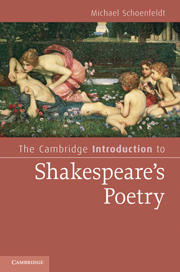Book contents
- Frontmatter
- Contents
- Acknowledgments
- Chapter 1 Shakespeare and English poetry
- Chapter 2 Shakespeare's banquet of sense
- Chapter 3 Constraint and complaint in Lucrece
- Chapter 4 Mysteries of the Sonnets
- Chapter 5 Time and mortality in the Sonnets
- Chapter 6 Friendship and love, darkness and lust
- Chapter 7 Solitary and mutual flames
- Chapter 8 Fantasies of Shakespearean authorship
- Notes
- Further reading
- Index
- Cambridge Introductions to Literature
Chapter 6 - Friendship and love, darkness and lust
Desire in the Sonnets
Published online by Cambridge University Press: 05 June 2012
- Frontmatter
- Contents
- Acknowledgments
- Chapter 1 Shakespeare and English poetry
- Chapter 2 Shakespeare's banquet of sense
- Chapter 3 Constraint and complaint in Lucrece
- Chapter 4 Mysteries of the Sonnets
- Chapter 5 Time and mortality in the Sonnets
- Chapter 6 Friendship and love, darkness and lust
- Chapter 7 Solitary and mutual flames
- Chapter 8 Fantasies of Shakespearean authorship
- Notes
- Further reading
- Index
- Cambridge Introductions to Literature
Summary
Love is friendship set on fire.
– Jeremy TaylorTime, the subject of the last chapter, matters so much to the poet of the Sonnets because it destroys everything we love and value. It assaults beauty, and enfeebles the subjects and objects of desire. Time, in other words, is important to Shakespeare because of its destructive relationship to the objects of our central emotional commitments. Haunted by transience, Shakespeare nonetheless resists the easy religious arguments about a transcendent afterlife that are at his fingertips, and that were the occasion of comfort for many lesser poets. Almost every sonnet in the 1609 Quarto deals in some way with some form or aspect of emotional attachment. Yet Shakespeare makes the sonnet cycle something more ethically complex than anything produced by previous writers. Beginning with a male speaker imploring a beautiful young man to reproduce, and concluding with a series of poems – the “Dark Lady” poems – that affiliate heterosexual intercourse with uncontrollable passion and incurable disease, Shakespeare's Sonnets radically disrupt the conventional heterosexual narrative of erotic commitment.
I would argue, though, that critics have sometimes made too much out of the divide between the Young Man poems and the Dark Lady poems, idealizing or over-simplifying the relationship with the former in order to denigrate or complicate the relationship with the latter. As we shall see, the Dark Lady poems only explore in a different tone the same concerns about the status of desire and stability of the self that run through the Young Man poems.
- Type
- Chapter
- Information
- The Cambridge Introduction to Shakespeare's Poetry , pp. 88 - 111Publisher: Cambridge University PressPrint publication year: 2010
- 1
- Cited by

